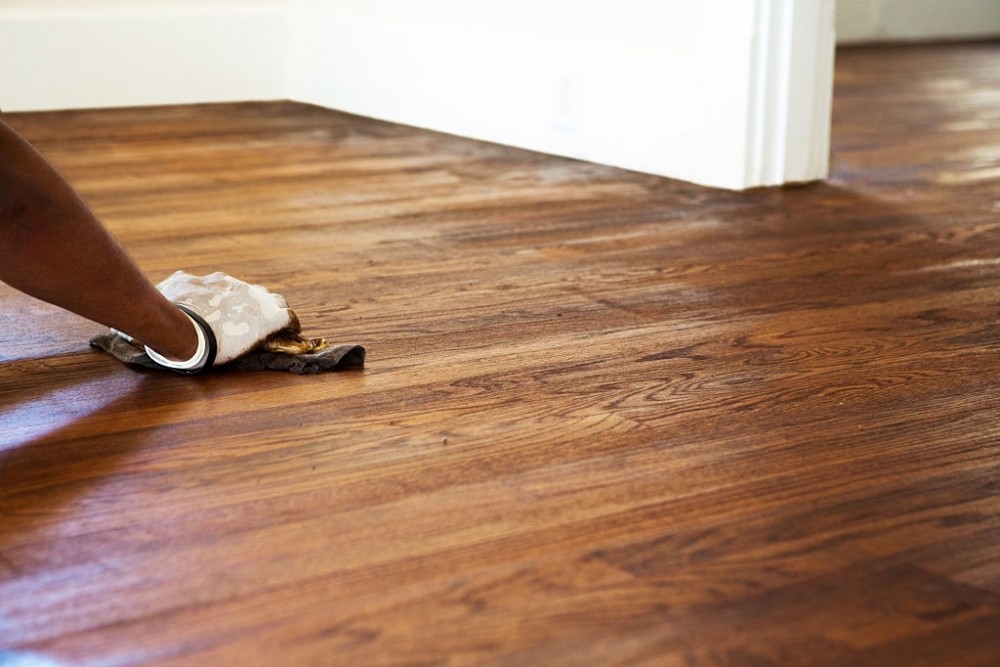
World's First Ceramic-Tile & Sanitaryware Live Marketplace. Get it on Google Play
Get it on App Store
World's First Ceramic-Tile & Sanitaryware Live Marketplace. Get it on Google Play
Get it on App Store
By Tileswale
Hardwood floor refinishing is an excellent way to update the appearance of a room without the hassle and expense of installing new flooring. Using a large sander, the top layer of the covering material is removed, removing the surface finish and digging down past any surface scratches, stains, or imperfections. As a result, you have a clean surface that can be stained and top-coated with whatever protective coating you want.
But remember that sanding will not remove very deep scratches, gouges, or stains. Even professionals advise homeowners to have realistic expectations about floor sanding results.
The wonderful thing about hardwood floors is that you can refinish them to make them look brand new as long as the wood is in good condition. Stripping a floor differs slightly from stripping a wood stairway or cabinet because chemical stripping agents tend to pool and harden between the planks. It is best to sand off the old finish with a power sander before applying a new stain and a finish coat. To complete this process successfully, you will require the following tools and materials:
Tools & Equipment |
Materials & Chemicals |
|
|
Hardwood floors can be expected to last a lifetime. Due to the wear and tear of everyday use, they will need to be refinished. Refinishing hardwood floors is a time-consuming, multi-step process. It can also be a fun do-it-yourself project that costs less and can be done easily if the following steps are followed:
Remove any carpeting or rugs from the room and move the furniture. Nail ridges should be hammered down. Slide the blade of a putty knife across the floor to locate pointy nails. Check for squeaks and use finishing nails to secure loose floorboards. Vacuum or mop the floor to remove any debris. Seal air vent covers to prevent sanding dust from entering your ductwork. Seal doors with plastic sheeting to keep dust out of the rest of the house.
Repair larger holes or cracks in the floor with wood filler and a spackle knife. If your floors are severely damaged, use a trowel filler, which is a thinner wood filler that spreads and covers large areas.
Hand-sand the perimeter of the room and any nooks the buffer can't reach with 180-grit sandpaper. Working 4 to 6 inches out from the baseboard, rub with the grain until the finish dulls and a powder forms. Avoid using a sanding block when refinishing hardwood because it may miss uneven spots on the floor.
Begin by sanding the boards with a drum sander, running the grain the length of the boards. Wear a dust mask, safety goggles, and ear protection whenever you use a drum sander. Over 3- to 4-foot lengths, sand back and forth with the drum sander. Use overlapping strokes at least one-third the width of the belt to remove scratches. Begin with a coarse 36 to 40 grit sandpaper, then progress to a medium 60 grit, and finally to a finer 100 grit. Avoid skipping the transition from coarse to fine grades.
Put on a dust mask and attach a buffing pad to the buffer. Move the buffer across the floor in the direction of the grain, 6 inches overlapping each course. As you work, the old finish turns to powder, making it easy to see which areas you've covered.
Select wood stain based on the colour and hardwood flooring type. Use a foam applicator pad to apply the stain in the direction of the wood grain. Work on one manageable area, such as four square feet, at a time. Many manufacturers suggest wiping away excess stains as you go, usually a few minutes after application. Remove excess stain with clean cotton cloths or paper towels. Allow the stain to dry thoroughly before applying the finish.
Using an applicator, apply the finish in smooth, even lines, avoiding drips. Apply three coats of oil-based finish or four coats of water-based finish. Lightly sand the floor after each coat has dried. Many finishes must dry for at least 24 hours. Before applying the next coat, vacuum up the dust. Once the finish has dried, reattach the shoe guard moulding.
Refinishing hardwood floors typically costs around Rs. 250 per Sq.Feet. While most wood floor refinishing projects cost between Rs.180 and Rs.280 per Sq. Feet, a high-end project, can cost around Rs. 320 per Sq. Feet. The total cost of your refinishing project will ultimately be determined by the size of the space, the condition of your wood floors, and the finishing materials you select.
You may be able to refinish your hardwood floor without sanding if it is only lightly worn, damaged, or scratched. There are two basic approaches:
Buffing the existing coat before refinishing
Using a chemical coat
In either case, you'll be able to refinish your hardwood floors quickly and easily, without the hassle, expense, or equipment required to sand to bare wood. However, using a screen and recoat technique is best to refinish wood floors without sanding. Scuffing up the finish with a floor buffer and applying a finish refresher coat are both required. The former is a tried-and-true floor restoration method, whereas the latter is a last-ditch attempt at floor care.
The majority of homeowners believe that sanding, staining, and resurfacing hardwood floors are the only way to give the old materials a new look. However, these projects generate a lot of wood dust. Most scratches are surface level and can be easily repaired in a single day of refinishing. There are three cheapest ways of resurfacing hardwood floors:
Using a Store-Bought Abrasion Kit
Recoating with Polyurethane Solution
Applying a Revitalizer
Furniture After Oil-Based Polyurethane:
Because these floors are oil-based, you should not rush to reinstall the furniture. As a result, if time is not a luxury, consider this when choosing. You will have to wait 3 to 4 days to put furniture on these floors.
Furniture After Water-Based Polyurethane:
Despite the fact that it sets up faster than the previously mentioned one, it still requires recovery time. However, unlike oil-based poly floors, this floor can be walked on after two to four hours or more. When it comes to furniture, bring it in after 72 hours. Allowing it to cure for a longer period of time wouldn't hurt either.
We suggest waiting 6 hours before walking in socks on your new floors. After 24 hours, you can enter with your shoes on. Allow 48 hours before reintroducing furniture and pets. After one full week, carpets and area rugs can be installed.
The majority of people do not consider the medical implications of finishing hardwood floors. If you are considering refinishing your floor, we strongly advise you to consider the health implications because improperly applied floor finish can make you and your family ill. The noxious odors and chemicals will not disappear in a few days and, in some cases, will not disappear in a few months. Even under ideal conditions, we discovered that restaining hardwood floors will likely double the chemical levels in your home.
Hardly anything outperforms the appearance of beautiful resurfacing hardwood floors. The wood's natural grain and the color's warmth lend a sense of coziness or even elegance to your home. However, you should expect some mess if you're installing new hardwood or refinishing existing floors. Both processes involve a number of complex steps, each of which can generate a significant amount of debris.
Article Updated - June 14, 2022
Submit your inquiries, we will see the rest
size:
Quantity:

+ Requirements

We have received your Inquiry. We will soon connect you with relevent Sellers via tileswale App. download now!!

